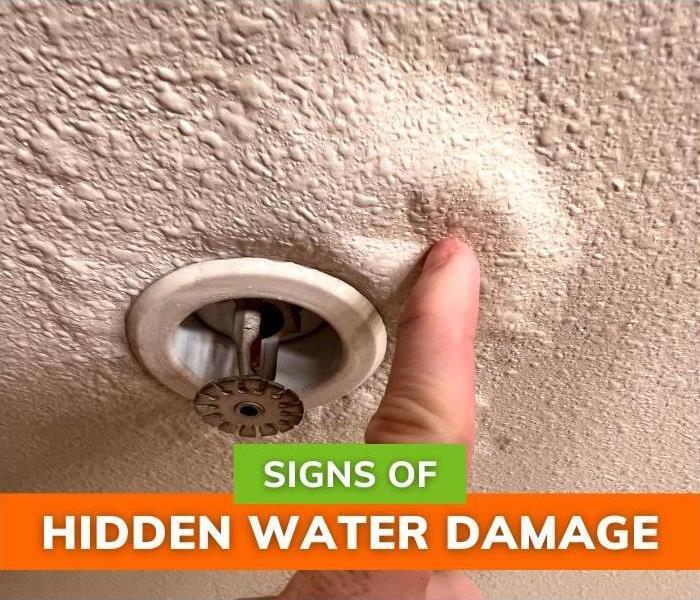Signs of Hidden Water Damage in Walls
4/9/2025 (Permalink)
Signs of Hidden Water Damage in Walls
Sometimes, water damage leaves obvious signs, such as leaky pipes or water puddles on the floor. However, leaks can also start behind your walls and slowly deteriorate your pipes, building materials, and insulation. When you find the leak, you already have ruined drywall or significant mold contamination.
Knowing the signs of hidden water damage in walls can help you catch leaks early on. If you suspect water damage, HVAC professionals can inspect your pipes, walls, floors, and ceiling to find the source and repair the issue. They can also assist you during post-fire property recovery.
What Causes Hidden Water Damage?
Once you detect signs of hidden water damage in walls, you'll need to find the source to prevent further damage. Common causes of water damage include:
- Floodwaters
- Excessive condensation
- Clogged or leaking pipes
- Gaps in your roof
- Foundation cracks
- Broken appliances
- Inadequate window seals
Clean water doesn't contain pollutants, making it safer to handle. Some appliances produce grey water, which contains food particles. Black water is sewage that may contaminate your house with bacteria, parasites, and feces. This kind of water damage requires you to sanitize the space.
What Are the Signs of Water Damage?
Soft Drywall
When water seeps into drywall, the material eventually softens and crumbles, leaving you with stained, sagging drywall that detracts from your home's appearance. If you have wallpaper, look out for peeling or discoloration. Wet drywall is often a breeding ground for mold and mildew. Worse, the drywall could eventually collapse and threaten your home's integrity.
Typically, professionals remove the damaged drywall before the moisture spreads any further. They might cut out the damaged section and dry the area, then replace any building materials that experienced water damage. If mold is a concern, they could sanitize your wall. Finally, they'll add new drywall and paint the area to make it look seamless.
Peeling Paint
As water trickles down your wall, the paint might feel soft and moist. Bubbling, flaking, and chipping are common. If you try to repaint your wall, the paint will flake off again, so contact water restoration experts. They'll clean and dry your wall so that you can remove the discolored paint and apply a fresh coat.
Trickling Water Sounds
Mysterious trickling sounds indicate that you have a leak that you can't see. The leak causes damage inside your walls that you might not notice until drywall collapses or your paint starts deteriorating. If you hear trickling noises, call for help as soon as possible.
Mold Growth
Mold and mildew growth are two of the biggest signs of hidden water damage to walls. When you enter a contaminated room, you may notice musty odors, sagging ceilings, and black splotches or discoloration on the walls. Mold exposure causes flu-like symptoms, such as coughing, sneezing, red eyes, and headaches. People with asthma could suffer from frequent attacks.
You can remove small mold patches yourself. However, if you have significant mold growth inside your walls, consider hiring professionals to open your walls, remove the spores, seal the leak, and dry the area. Additionally, if spores enter the ductwork, you might need to clean your entire house. Your HVAC system could circulate spores throughout your house, leading to further contamination.
High Water Bills
If your water bills keep rising and you haven't used more water than usual, you probably have a leak. During water damage restoration, professionals use tools to locate the source and shut off the leak. Afterward, they'll determine if you have clean water, grey water, or black water, then survey the damage and move furniture out of the way.
Excessive Humidity
While some condensation on your window is normal, excessive moisture may indicate a leak inside your walls. Check the seals around your doors and windows to see if they let moisture inside your house.
Wet Insulation
Wet insulation is typically less effective, creating cold patches in your house. Mold and mildew can also grow inside the insulation. If you have a small patch of wet insulation, you can dry it out. Otherwise, hire experts to replace your insulation before it contaminates your space with bacteria.
Low Water Pressure
Low water pressure may indicate that your pipes have sprung a leak. As water spills out of the gap, your faucet produces a trickle instead of a full blast. Leaks are particularly common in older houses with outdated and corroded pipes.
Efflorescence
Efflorescence is a white, chalky substance that you find on wood, brick or concrete walls. This substance indicates that you have water leaking and drying on your walls, leaving salts and minerals behind. Over time, the water gradually seeps into your walls and weakens the structure until they're in danger of collapsing.
You can clean efflorescence off the surface, but you'll need to repair the leak to keep it from happening again. Some homeowners cover their walls with waterproofing chemicals to prevent excess moisture.
Invest in Commercial Air Duct Cleaning
If you detect musty smells, mold mildew growth, or poor indoor air quality (IAQ) in your house, contact SERVPRO® of Arcadia to learn more about commercial air duct cleaning. We'll use professional equipment to clean your ducts, improving their efficiency and boosting your IAQ. This service also extends your ductwork's lifespan.






 24/7 Emergency Service
24/7 Emergency Service
